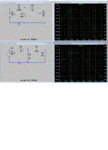code2zero
Newbie level 3
I am designing a Band Pass filter.
I tried to swap the order in which the filters( LP and HP) are used. and found out that I get two different result. If I calculate the transfer function of the band pass filter I shouldn’t see any difference. But in my case LP-HP band pass filter has more loss than HP-LP filter. Can anyone explain this why this is happening. Please find the attached gif file for circuit and simulation.
~kk

I tried to swap the order in which the filters( LP and HP) are used. and found out that I get two different result. If I calculate the transfer function of the band pass filter I shouldn’t see any difference. But in my case LP-HP band pass filter has more loss than HP-LP filter. Can anyone explain this why this is happening. Please find the attached gif file for circuit and simulation.
~kk

